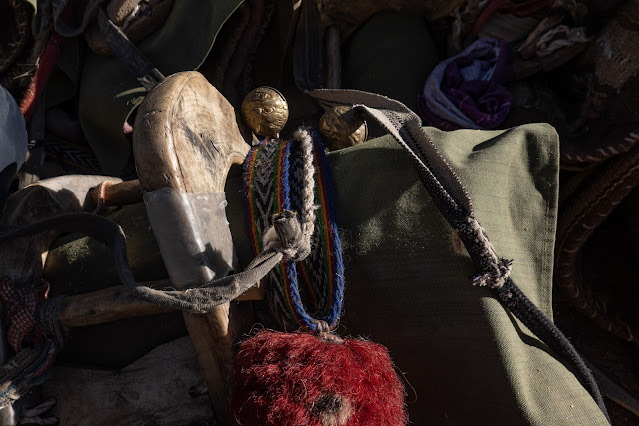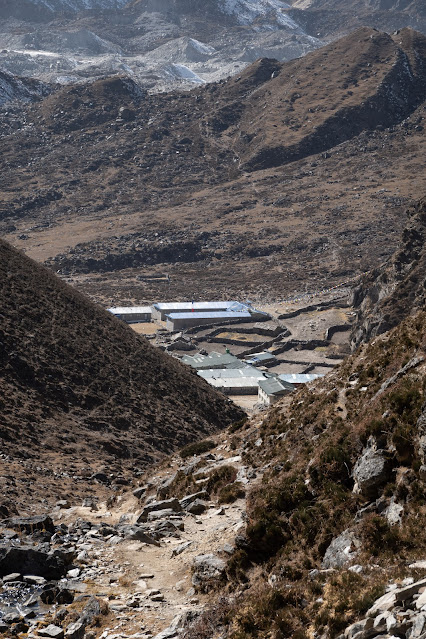Photo Friday: Trekking Nepal Part VIII
For those who have just discovered this, the previous posts about my trek through the Everest Region in November 2021:
Kathmandu
Part I: Lukla to Namche
Part II: Namche to Khunde
Part III: Khunde to Pangboche
Part IV: Ama Dablam Basecamp to Dingboche
Part V: Chukkhung
Part VI: Kongma La
Part VII: Everest Base Camp
Part VIII: Over Cho La
Day 14: To Dzonglha kharka
Naturally, after our snow-day issues the previous day on Kala Patthar, the sun was shining and the weather perfect as we moved on.
 |
| The sun hitting Taboche Peak as we leave Lobuche |
We hiked down the Khumbu valley until it met the next valley, and turned right.
 |
| Looking back where we'd been days before. The trail on the left is the one used by those who didn't do Kongma La. We all came up the valley to the bend. |
Rounding the corner, we encountered fantastic views of Taboche, Cholatse, and Arakam Tse (peaks from left to right), the Chola glacier, and Chola Tsho (the green glacial lake). By this point I was hiking in shirt sleeves; my last such day until we got low again.
After a half hour or so, Dzonglha kharka came into view--you'll have to look very close, but roofs are just visible in roughly the center of the picture. A kharka is a seasonal yak-herding encampment, in this case expanded to include a couple of hotels for trekkers crossing the pass.
 |
| I was much occupied here in trying to figure out where our pass was. Between the two low pointy peaks on the skyline, as it turns out. |
 |
| A massive delta of glacial silt running into Chola Tsho. Water level seemed low. |
We arrived early, so took the chance to do more laundry. The water at the Hotel Zongla Inn came from a spring, apparently, and was far warmer than the usual snowmelt (it may simply have come from a long way in a black plastic pipe. Either way, it felt genuinely warm).
 |
| Yak saddles |
Sadly, the fog moved up the valley and sun went behind the peaks. In the end, our clothes were freeze-dried, not sun-dried. At just under 16,000, this was one of our higher lodges, and shaded by the peaks from about 2:30 in the afternoon, so was an extra cold spot.
Day 15: Over Cho La
The Cho La pass goes up over a glacier, so the yaks couldn't come with us. They would go a very long way around and rejoin us in Gokyo in two days, so we had to decide what was essential for one night and pack that either in our own daypacks or have the guides carry it. I'm pleased that our whole group was very disciplined, and kept gear to a minimum. As one member of the party was not feeling well, he and his wife took a helicopter over the pass, which also helped--they carried as much as they could on the chopper with them to spare the porter.
Facing a long day, we started a half hour earlier than usual. Breakfast at 6:30 a.m. on a morning when my water bottle (next to my bed in our room) was slushy wasn't easy, but we did it, and hit the trail at 7:20. I noticed the extra weight in my daypack, but it wasn't bad.
 |
| Up around the corner right below the peaks. |
 |
| Glacial activity can leave big flat spots. They are pretty nice to encounter when crossing a pass at 17,613'. |
Turning the corner, we could see we had to cross the ridge into the next drainage to continue our climb to the pass. Given what the head of this valley looked like, I was relieved.
This is why we've been carrying micro-spikes (okay, we used them on Kongma La, too). We'll be going straight up this small but very hard glacier (so small it doesn't even have a name).
 |
| My son, ready to continue as always. The porter's load is leaning on the pole--really quite modest compared to some we saw. |
 |
| Crossing the glacier would have been horrible without the spikes, but with them was an easy walk. |
 |
| At the top of the glacier, it was a bit of a scramble to the pass, but fortunately there was a fixed cable, and our guides added a rope for hauling ourselves up. |
I love passes, in part because they are the view and the route to whole new worlds--new drainage basins.
 |
| Stepping carefully down between icy patches. |
 |
| I could have cried when I finally saw the village. Even my "personal guide" (sent to keep me company as I was faster than others and slower than my son) was showing signs of fatigue by this point. |
Just kept going, on through the village. Our hotel was (as usual) the last in town.
 |
| Classic Sherpa house. Solar panel and chimney are modern additions. |
 |
| Water powered prayer wheel. This was in a little building that stood over the stream. |
Arrived at last at the Chola Pass Resort, and was greeted cheerfully by our flying companions. Sunshine on the terrace felt great!
 |
| Welcome! |
Next up: Gokyo. I'm thinking 2, maybe 3 more posts to get us home!
Oh, and I have no idea why many of the photo captions turned blue. I decided it wasn't worth the time to figure it out. Sorry about that!
Read the whole story:
Kathmandu
Part I: Lukla to Namche
Part II: Namche to Khunde
Part III: Khunde to Pangboche
Part IV: Ama Dablam Basecamp to Dingboche
Part V: Chukkhung
Part VI: Kongma La
Part VII: Everest Base Camp
Part VIII: Cho La
Part IX: Gokyo
Part X: Renjo La
Part XI: Thame Valley to Home
©Rebecca M. Douglass, 2022
As always, please ask permission to use any photos or text. Link-backs appreciated.
Don't miss a post--click the "Follow-it" link below!









Seriously, Rebecca! This is amazing! More power to you. I LOVE all the photos and am enjoying your journey. Yes, it's true. I'm reading this in a comfortable chair by a fire. All best to you and your son!
ReplyDeleteThanks! My goal is to let people enjoy the trip without getting cold and tired!
DeleteA lot of elevation on this stretch!
ReplyDelete